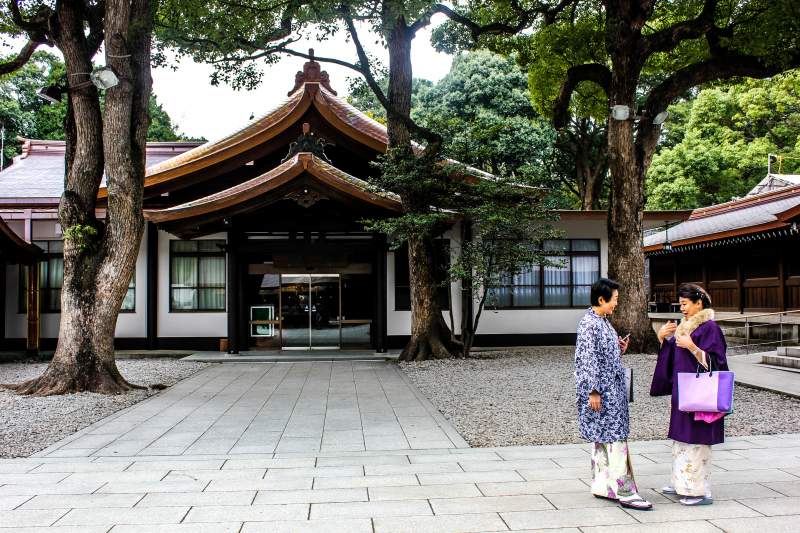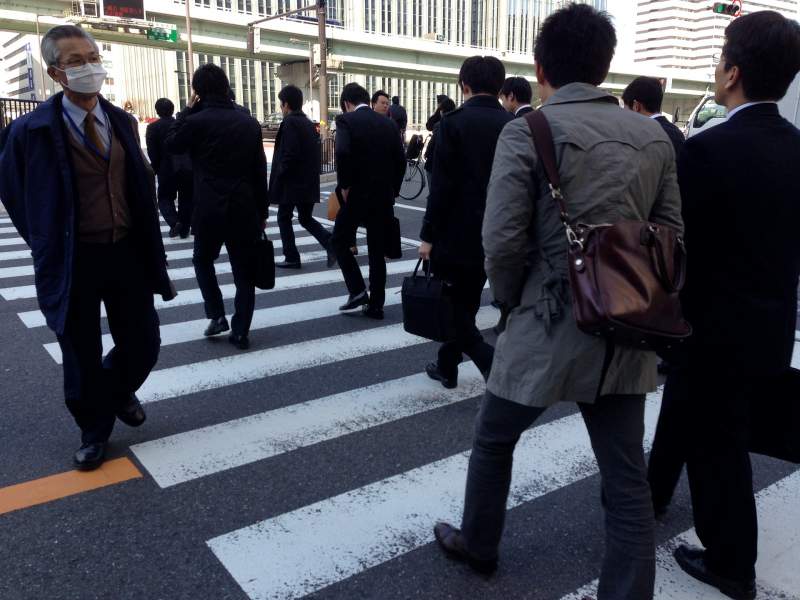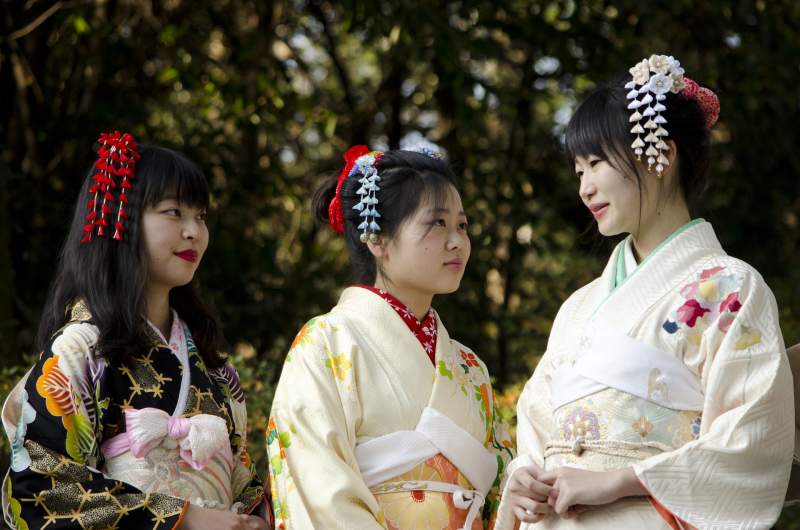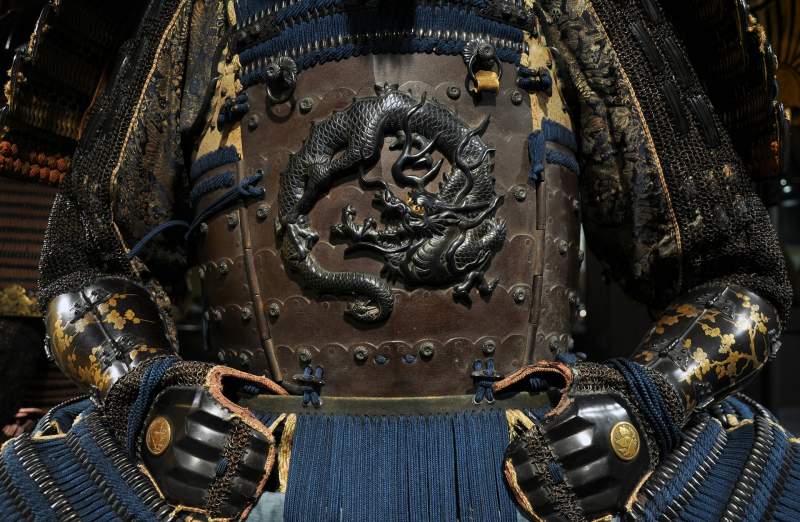
Are you learning Japanese through textbooks or something a little less traditional?
If your first exposure to Japanese was through pop culture (think J-pop, anime, or movies), you’re probably used to young people tacking on a friendly -kun or -chan to someone’s name.
If you’ve simply heard some Japanese here and there, maybe you’ve wondered why everyone’s name seems to end in -san.
Well I’ve got a surprise for you—these little tags aren’t part of people’s names at all! They’re Japanese suffixes or Japanese honorifics, and you'll cover all of them in this post so you know when, why, and how to use them.
Don’t sweat it—this’ll be easy. By the end of the post, you'll know exactly when (and when not) to use each of the Japanese suffixes. So you'll sound more polite or friendly in Japanese and fit in more easily with native speakers.
By the way, if you want to improve your Japanese quickly and having fun doing it I recommend Japanese Uncovered, my comprehensive course that teaches you through the power of story. Click here for a free 7-day trial of the method.
Table of Contents
Why, When And How Do You Use Suffixes In Japanese?

Japanese suffixes are one of the easier aspects of Japanese culture and language to master. Unlike learning kanji or learning to write in Japanese, suffixes are quick and easy to master.
So much so that you can't really go wrong, especially if you follow the golden rules below about when and how to use Japanese suffixes that I'll share with you below.
Why Do You Use Suffixes In Japanese?
In many languages, some words or pieces are attached to people’s names to clarify more about them. Think of terms like:
- Mr.
- Ms.
- and Dr.
In Japanese, language pieces like these exist—the only difference is that unlike in English, Japanese titles like these are placed at the end of a person’s name. That’s why they’re called suffixes.
Just like in other languages, Japanese suffixes exist to clarify the relationship between people or tell you more about a person’s rank or role.
Honorifics are incredibly important in Japan’s hierarchical society, so it’s crucial to learn them early. The good news is that they’re really very simple.
But when do you use them?
When To Use Suffixes In Japanese
If you’re asking when you’re supposed to add these suffixes to people’s names in Japanese, the answer is very simple—always.
You can never only call someone by their name in Japanese.
While saying, “Hey Matt, wanna go to the store?” in English is perfectly fine, in Japanese, saying the same (Ne, Matt, mise ni ikou ka? ね、マット、店に行こうか?) without adding a suffix to Matt’s name will produce either odd looks or even slight offence.
“If it’s so important to use suffixes all the time, how do I use them?”
Excellent question. Thankfully, the answer to how to use them is just as simple as the answer to when to use them.
If you take only one thing from this article, let it be this: when in doubt, use –san (さん).
3 Golden Rules For Japanese Honorifics
Before we look at the honorifics themselves, it’s important to go over a few basic concepts.
- Use honorifics whenever speaking to someone who isn’t a member of your close family. Even friends! Err on the side of politeness; if someone doesn't want you to use an honorific, they will let you know.
- Never (ever, ever) use honorifics when talking about yourself. It’s considered not only strange but also rude. If you want to convey information establishing your age or professional title relative to the person you’re speaking to, just provide that information during the conversation; the person you’re speaking to will apply the honorific. (Similarly, listen for that information about the person you're speaking to so that you can use the right honorific for them!)
- Japanese sentences rarely use the pronoun “you” in conversation or writing. Instead, they use first or last names. While it sounds strange in English to refer to people in the third person when talking to them, the opposite is true in Japanese.
Say you’re having a conversation with an acquaintance named Ken. In English, we’d ask:
- You like sushi, right?
In Japanese, however, “you” would be replaced with “Ken”:
- Ken likes sushi, right?
- ケンさんは寿司が好きでしょう。
- Ken-san ha sushi ga suki deshou.
- ケンさんは寿司が好きでしょう。
As you can see, this sentence attaches the honorific san (さん) to Ken’s name; I’ve put it in bold, both in hiragana and romanisation, for easy identification. Simple, right? Now, let’s take a look at the honorifics!
The 4 Most Common Japanese Honorifics & When To Use Them
So, you already know that –san(さん) is the all-purpose, life-saver honorific.
But Japanese has a number of suffixes beyond –san. And if you learn them all, you’ll never be lacking ways to describe someone!
Some you may already be familiar with, others may be new. Take a look below and see if you spot any Japanese suffixes you recognise!
#1 -San (さん)

The suffix –san (さん) is the workhorse of the Japanese suffix world. If you don’t know what to use on someone, use –san.
That's because San (さん) is the all-purpose honorific, a neutral term that can apply to anyone regardless of age, gender, or social position. Its closest equivalent is Mr/Mrs/Ms/Miss in English. And it’s polite, so you’ll never offend someone.
To affix it to someone’s name, just put it right onto the end of the name. Matt becomes Matt-san, and there you have it! The same is true of all other Japanese suffixes.
Fun fact: in addition to using –san for just about everybody (even your friends!), you can create new words using this suffix.
If you’re shopping at a kutsuya (shoe store), you can address the workers as kutsuya-san, which literally means “Mr./Ms. Shoe Store.”
But it's actually taken to mean “gentleman/lady who works in this shoe store.” If you need someone’s help but don’t know their name, you might be able to use –san anyway!
#2 -Sama (様, さま)

You'll rarely hear –sama (様, さま), the much more formal version of –san (さん), in general conversation.
Because of its politeness, you’re likely to use –sama in only a few very specific circumstances, such as:
- when addressing customers, if you work at a shop. The word for customer, okyakusuma (お客さま, おきゃくさま), includes the honorific!
- when addressing a business client in an email
- addressing an entire family if you write a New Year’s card
- or speaking to someone of high rank or who garners deep respect (think political figures, the head monk at a temple, or someone you deeply admire)
- when answering the phone and unsure of the right honorific to use for someone
As you can imagine, you’ll encounter this suffix more frequently if you work in Japan than if you’re just visiting. Here's an example:
- I’m sorry, could you tell me who is calling?
- 失礼ですが、どちら様ですか。
- Shitsurei desu ga, dochira-sama desu ka?
- 失礼ですが、どちら様ですか。
#3 -Kun (君, くん)

Kun (君, くん) is an honorific that is gender- and age-specific. You should only use kun (君, くん) when speaking to a male who is younger than you – usually a teenager or young adult.
It’s slightly casual. But you’ll still find it in a variety of business settings, such as among friendly male coworkers of the same rank. The kanji is actually the same as that for kimi, an informal way of saying “you.”
You’re also likely to hear it from a superior speaking to someone of a lower rank.
If you’re looking for opportunities to use -kun, try it out with your male friends!
For example, a senior in high school might say the following to Takeshi (たけし), a male friend two grades below them:
- Takeshi, did you eat too much?
- たけしくん、食べ過ぎだった?
- Takeshi-kun, tabesugi datta?
- たけしくん、食べ過ぎだった?
On the other hand, if Takeshi were older, the person speaking to him would use -san (さん).
#4 -Chan (ちゃん)

The -chan (ちゃん) suffix is in many ways the “feminine” equivalent of -kun. You can use it for or among girls, though it has a number of other uses too such as talking to or about babies, small children, grandmas, and animals.
Couples and close friends also use chan (ちゃん), especially for women. It’s thought to have originated from babies and children who struggled to say san (さん).
If you’re looking for an on-point way to clarify just how cute you think something (or someone) is, -chan is the way to go. Whether it’s calling a little kid by -chan or naming your tiny, yippy little dog Yuki-chan, sweetness is the name of the game if you’re using -chan.
But I'd recommend that you keep this one out of business or formal relations. Instead, use it in a context like the one below.
For example, imagine a little girl (or boy) comes out of a fitting room wearing a cute outfit. Their mother might say:
- Mao, you’re so cute!
- まおちゃん、かわいい!
- Mao-chan, kawaii!
- まおちゃん、かわいい!
Never use chan (ちゃん) at work or when speaking to someone older.
2 Honorifics You Mostly Come Across In J-Drama And Anime
Because so many people fall in love with Japanese through manga, anime, or J-dramas, I wanted to let you know about two Japanese honorifics you might hear a lot when watching these kinds of shows.
Neither is common at all outside of these programmes. Phew!
#5 Tono/Dono (殿、との/どの)

Pronounced tono (殿、との) when on its own and –dono (どの) when attached to a name, tono/dono is one step down from sama (様, さま) and means “lord”.
Suffixes like -dono are the sort where you’ve either heard them consistently or never before.
The reason for this is its common appearance in anime. Otherwise, the -dono suffix is largely archaic, so you’re unlikely to hear it.
If you do, it’s probably being used in a joking manner.
You can sometimes use it with a pinch of humour to poke fun at someone’s age—like calling that grumpy man down the street “Old Man Bill” even though he’s barely past 40.
- Using -dono in normal conversation? Not recommended.
- Using -dono while conducting a stage play about the 18th-century Japanese military? The more the better.
#6 Me (奴, め)
Me (奴, め) is a derogatory honorific (almost an oxymoron!) that you’ll often see used in anime and manga.
It can be attached to anyone or anything – people, animals, inanimate objects, pronouns – to express strong dislike or anger.
Avoid using it in conversation, even in jest, unless you’re very close to someone who uses it with you in conversation.
Japanese Suffixes That Stand On Their Own
In this section, you'll discover some unique honorifics that can stand on their own, separate of someone’s name. Including one that you must never use as a suffix. If it sounds confusing, don't worry, it really is pretty simple.
#7 Senpai (先輩、せんぱい)

The word senpai refers to someone within your circle or group—think school, your department at work, and so on—who outranks you, most often in experience but potentially in age.
A first year at secondary school or uni would address an older student as senpai, as would an intern addressing a coworker with more experience.
Could you use –san here? Sure. You can always use –san. But it’s nice to have options.
If Matt is one year ahead of you in school, you could refer to him as Matt-senpai. Similarly, you could simply say that Matt is your senpai, because the word senpai can stand on its own as well.
Here’s an example:
- Takasaki, congratulations on your graduation!
- たかさきせんぱい、卒業おめでとうございます!
- Takasaki-senpai, sotsugyou omedetou gozaimasu!
- たかさきせんぱい、卒業おめでとうございます!
#8 Kohai (後輩、こうはい)
The opposite of a senpai (先輩、せんぱい) is a kohai (後輩、こうはい), or one who is ranked lower. If you're a year ahead of Matt, he is your kohai.
However, unlike -senpai, you never use kohai as a suffix. You won’t hear people talking about Matt-kohai. So keep in mind that while senpai is versatile in its uses, you'll hear kohai less often and it gives you fewer options.
Why don’t we use kohai as a suffix like we do with senpai? Well, when we’re talking about kohai, we’re talking about people with less experience or who are not as good at something as others.
Directly calling people out on that could be sort of condescending, right? So kohai just end up being called –san, the great equalizer.
Just to clarify how this difference works in practice, imagine that Takasaki in the senpai example above is younger than you – a senior graduating high school while you are in college – and you want to congratulate him.
You’d say:
- Takasaki, congratulations on your graduation!
- 後輩、卒業おめでとうございます!
- Kohai, sotsugyou omedetou gozaimasu!
- 後輩、卒業おめでとうございます!
Pretty simple, right?
#9 -Sensei (先生、せんせい)

Many people likely recognise this word, which functions both independently and as a suffix. My Japanese teacher’s name was Nagatomi-sensei. Nakajima-sensei worked at a different school nearby.
It’s also entirely correct to simply say that Nagatomi-san was my sensei, which means “teacher” or “expert.” It also literally means “formerly”.
Anytime you’re addressing someone who is instructing you, no matter the subject (athletics and art, as well as academics), use sensei (先生、せんせい). It can be attached as a suffix to their last name, and it can also be used on its own.
Take the following example:
- Ms Tanaka, I have a question.
- 田中先生、質問があります。
- Tanaka-sensei, shitsumon ga arimasu.
- 田中先生、質問があります。
You can also say:
- Teacher, I have a question.
- 先生、質問があります。
- Sensei, shitsumon ga arimasu.
- 先生、質問があります。
Use of the word sensei isn’t limited only to academic teachers, though. If you ever speak to a lawyer or doctor in Japan, you’ll find that they also go by -sensei.
This ties back into the idea that the word sensei means “expert.” People like lawyers, teachers, and doctors have mastered a subject or skill, and so they have become experts in it.
Because of this, –sensei is a very respectful suffix. The only time you’ll hear it outside of these contexts is in sarcasm.
Maybe by a friend who, on noticing that Matt failed his maths test after bragging that it would be super easy, ribs on him by asking “how Matt-sensei did on the test.”
#10 Hakase (博士, はかせ)
Hakase (博士, はかせ) is even more formal than sensei and is used to refer to anyone who has achieved the highest level of academic expertise: a medical doctor, anyone with a doctoral degree (e.g.,PhD), a highly regarded researcher, etc.
Like sensei, it can be both a suffix and a stand-alone word:
- Dr. Tanaka, I have a question.
- 田中博士、質問があります。
- Tanaka-hakase, shitsumon ga arimasu.
- 田中博士、質問があります。
- Professor, I have a question.
- 博士、質問があります。
- Hakase, shitsumon ga arimasu.
- 博士、質問があります。
Bonus Japanese Honorifics
You're doing such a great job understanding Japanese honorifics that I thought I'd add some extra ones into the mix. This way, you really know everything there is to know about this topic, for now at least!
Two Prefixes That Express Respect And Humility: O- (お) and Go- (ご)
While o- (お)and go- (ご)are not technically honorifics, they are prefixes attached to animate and inanimate nouns to elevate the formality of a conversation.
They are two of the many ways to express kenjougo (謙譲語), or humble language, which is itself acrucial part of keigo (敬語), or respectful language.
Basically, you use kenjougo (謙譲語) when you want to show respect to someone during a conversation.
In general, o- (お) appears before words with Japanese roots and go- (ご) before words with Chinese roots, though there are exceptions. Right now, the key is to recognise that their use indicates a high level of formality and respect.
Business Honorifics
A few honorifics are specific to businesses and can be helpful to know if you work in Japan.
Here they are, in order of rank:
- shachou (社長), company president (usually the CEO)
- kaichou (会長), president or chairman (often a retired president or company founder)
- kachou (課長), section chief or manager
- buchou (部長), general manager or department head
That’s it for Japanese honorific suffixes!
Japanese Suffixes FAQ
What Are Suffixes In Japanese?
Japanese suffixes, or honorifics, are added to names to show respect, familiarity, or social status.
Common ones include -san (さん, general polite), -chan (ちゃん, affectionate/diminutive), -kun (くん, casual for boys), and -sama (様, very respectful).
What Is Chan vs San vs Kun?
-San (さん) is a general polite suffix used for most adults.
-Chan (ちゃん) is a cute or affectionate suffix often used for children, close friends, or women.
-Kun (くん) is typically used for boys, younger men, or colleagues in a casual setting.
Can You Use Kun For A Girl?
Yes, -kun can be used for girls, especially in a workplace or school setting, but it is less common than for boys.
It is sometimes used by teachers or bosses to address younger female employees or students in a casual but respectful way.
What Is The Japanese Suffix For A Girl?
The most common suffix for girls is -chan (ちゃん), which expresses affection or cuteness. -San (さん) is also commonly used for women in a polite and respectful way.
How Can You Go Wrong With Japanese Suffixes?

You often can’t, to be honest. If you stick with -san, you’ll be hard-pressed to offend anyone. Addressing someone as -sama just to be safe will likely garner an entertained chuckle and a “-san is fine!” response.
The only Japanese suffixes you need to keep your eyes on are -chan and kohai. Remember not to call anyone outranking you -chan, and never use kohai as a suffix.
If you follow these simple rules, you’ll have no problem keeping the peace in every Japanese conversation!
Maybe throw in a -dono next time you’re talking with your close friends. See how confused and amused they get.
And remember, if you want to build rock-solid foundations in Japanese, I recommend Japanese Uncovered, my comprehensive course that teaches you through the power of story.
The course covers everything you need to know as a beginner in Japanese (including Japanese suffixes), so you can start enjoying the language sooner.

Olly Richards
Creator of the StoryLearning® Method
Olly Richards is a renowned polyglot and language learning expert with over 15 years of experience teaching millions through his innovative StoryLearning® method. He is the creator of StoryLearning, one of the world's largest language learning blogs with 500,000+ monthly readers.
Olly has authored 30+ language learning books and courses, including the bestselling "Short Stories" series published by Teach Yourself.
When not developing new teaching methods, Richards practices what he preaches—he speaks 8 languages fluently and continues learning new ones through his own methodology.









































